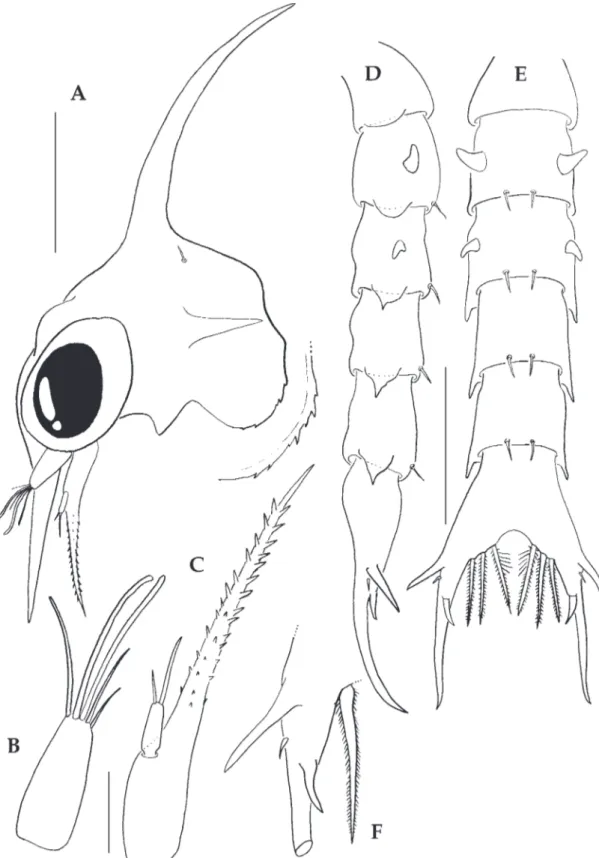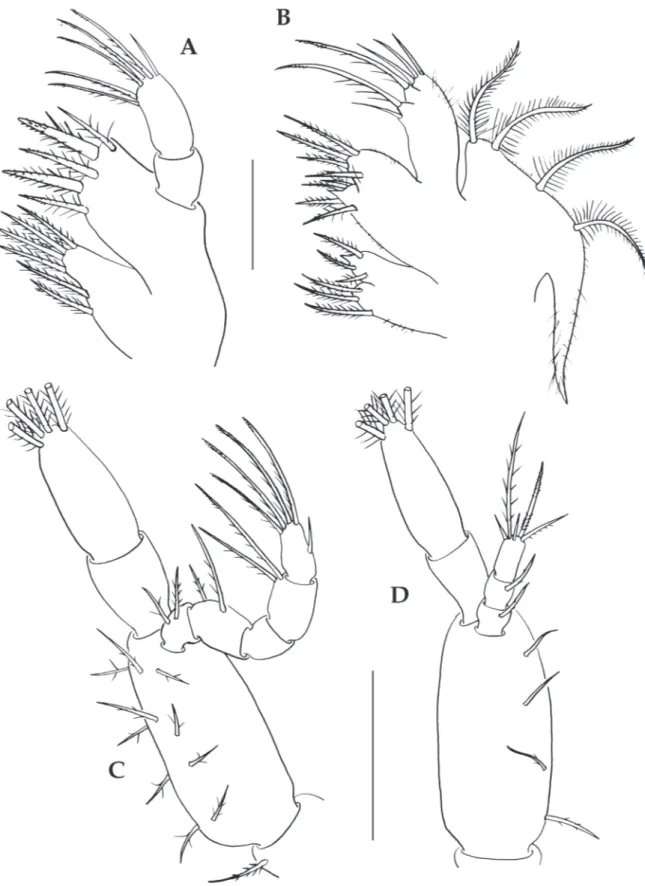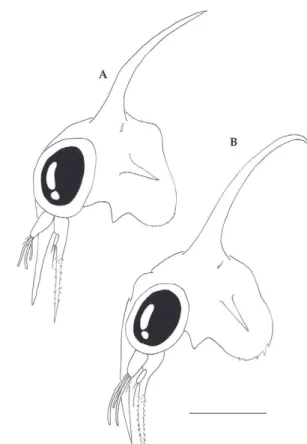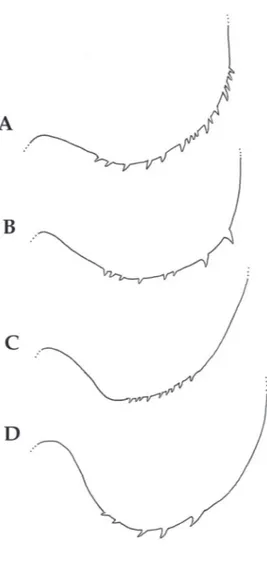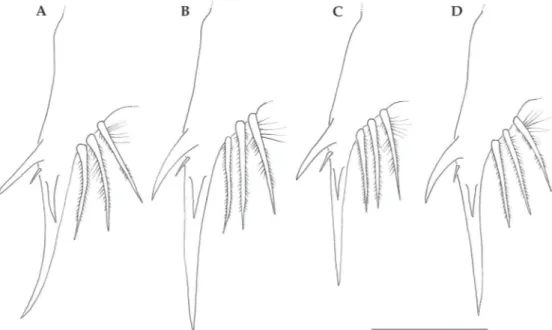Printed version ISSN 0001-3765 / Online version ISSN 1678-2690 www.scielo.br/aabc
Morphology of the first zoeal stages of five species of the portunid
genus
Callinectes
(Decapoda, Brachyura) hatched at the laboratory
FERNANDO L. MANTELATTO1, ÁLVARO L.D. REIGADA2, ALINE C.R. GATTI1 and JOSÉ A. CUESTA3 1
Programa de Pós-Graduação em Biologia Comparada, Laboratório de Biogeologia e Sistemática de Crustáceos/LBSC,
Departamento de Biologia, Faculdade de Filosofia, Ciências e Letras de Ribeirão Preto/FFCLRP,
Universidade de São Paulo/USP, Av. Bandeirantes, 3900, 14040-901 Ribeirão Preto, SP, Brasil 2PPG-ECOMAR, UNISANTA, Rua Oswaldo Cruz, 266, 11045-907 Santos, SP, Brasil
3
Instituto de Ciencias Marinas de Andalucía/ICMAN-CSIC, Avenida República Saharaui, 2, 11519 Puerto Real, Cádiz, Spain
Manuscript received on January 24, 2013; accepted for publication on September 9, 2013
ABSTRACT
The genus Callinectes Stimpson, 1860 currently consists of 16 species, six of which are reported in Brazilian coast. In the present study, the first zoeal stages of Callinectes bocourti, C. danae, C. exasperatus, C. ornatus and C. sapidus from Brazil were obtained from ovigerous females. The morphological and meristic characters of all these larval stages are described and illustrated. Those of C. bocourti, C. danae and C. sapidus are redescribed and compared with the previous descriptions, and differences are listed. Larval characters of these species were examined for interspecific differences, as well as larval features to distinguish the genus Callinectes within Portunidae. In addition, other portunid genera and species with a known first zoeal stage are compared, with special attention to those species present in the same geographical area. Our findings concord with some previous molecular studies, and we discuss the complexity within the group.
Key words: larval morphology, Portunidae, Portunoidea, zoea.
Correspondence to: Fernando Luis Mantelatto E-mail:flmantel@usp.br
INTRODUCTION
Swimming crabs of the genus
Callinectes
Stimpson,
1860 are ubiquitous representatives of the
portunid fauna in tropical and subtropical waters.
Under present systematic treatments, 16 species
of
Callinectes
are currently recognized for this
genus worldwide (compiled from Rathbun 1930,
Stephenson and Campbell 1959, Williams 1974,
1984, Melo 1996, Schubart et al. 2001, Robles et al.
2007, Ng et al. 2008). Six are reported in Brazilian
waters:
Callinectes affinis
Fausto-Filho 1980
, C.
bocourti
A. Milne-Edwards 1879,
C. danae
Smith
1869,
C. exasperatus
(Gerstaecker 1856),
C. ornatus
Ordway 1863 and
C. sapidus
Rathbun 1896.
Despite the ecological, evolutionary and
eco-nomic importance of
Callinectes
, controversies
remain regarding the systematic arrangement of
the genus (Williams 1974, Norse 1977), which
has been based up the present on morphological
and physioecological data. The validity of
morphological characters was tested by molecular
tools only recently (Schubart et al. 2001, Robles
et al. 2007). However, despite the unquestionable
importance of larval morphology for the study
of phylogenetic relationships (Rice 1980), larval
descriptions are not available for most species
and many genera of portunids; and many existing
descriptions are incomplete or erroneous. Larval
information is available for less than 8% of all
known portunid crab species.
Considering this promising scenario for
taxonomic investigation and the potential for zoeal
morphology to provide helpful information, we
describe and illustrate here the first zoeal stages
of five species (Callinectes bocourti
,
C. danae
,
C.
exasperatus
,
C. ornatus
and
C. sapidus
) hatched
in the laboratory, and compare their morphology
with described zoeae of other portunid species. The
morphology of the zoea I of
Callinectes exasperatus
and
C. ornatus is described for the first time, and
the zoeae of
C. bocourti, C. danae
and
C. sapidus
are redescribed and compared with the previous
descriptions by Lopes et al. (2000), Sankarankutty
et al. (1999) and Costlow and Bookhout (1959),
respectively. The differences in morphology are listed.
MATERIALS AND METHODS
Ovigerous females were obtained by trawling in two
regions (São Vicente and Ubatuba) of the coast of
São Paulo, Brazil, during 2002 and 2003. Females
were transported to the laboratory, and the ovigerous
females were isolated in aquaria with aerated sea
water at a salinity of 34 psu and constant temperature
(24 ± 1°C) until hatching. Newly hatched zoea
stages were fixed in a 1 : 1 solution of 70% ethanol
and glycerin. The first zoeae were dissected for
detailed examination under a stereoscope, and
mounted on semipermanent slides. Measurements
and morphological characters were checked using
a compound microscope equipped with a
camera
lucida
. A minimum of 10 specimens were used for
measurements, and 20 specimens for descriptions.
For the zoeae I the following measurements
were taken: cephalothoracic dorsal spine length
(DL), distance from the base to tip of the dorsal
spine; cephalothoracic rostral spine length (RL),
distance from the base to tip of the rostral spine;
rostrodorsal length (RDL), distance from the tip
of the rostral spine to the tip of the dorsal spine;
cephalothorax length (CL), from between the
eyes (base of the rostrum) to the postero-lateral
cephalothorax margin. The descriptions follow the
standard proposed by Clark et al. (1998). The long
terminal plumose natatory setae on distal exopod
segments of the first and second maxillipeds are
drawn truncated. We followed the seta and setal
classifiation proposed by Garm (2004).Voucher
samples of the parental female and zoea I of all
species were deposited in the Crustacean Collection
of the Biology Department (CCDB) of the Faculty
of Philosophy, Sciences and Letters of Ribeirão
Preto (FFCLRP) at the University of São Paulo
(USP) under accession numbers CCDB
4256-4271. The collections of specimens conducted in
this study complied with current applicable state and
federal laws of Brazil (permanent license to FLM
for collection of Zoological Material No. 11777-1
MMA/IBAMA/SISBIO).
RESULTS
DESCRIPTION
A complete detailed description of the zoea I of
the type species of the genus,
Callinectes sapidus
,
as well as of the previously unknown zoea I of
C.
exasperatus
and
C. ornatus
are provided. For the
zoeae I of
Callinectes bocourti
and
C. danae
only
the differences with regards to that of
C. sapidus
are mentioned.
Callinectes sapidus
Zoea I (Figs 1-2)
Measurements: DL: 0.40 ± 0.02 mm; RL: 0.26 ±
0.03 mm; RDL: 0.96 ± 0.04 mm; CL: 0.39 ± 0.03 mm.
margin denticulate and without setae; one pair of
posterodorsal simple setae present; eyes sessile.
Antennule (Fig. 1B). Uniramous, smooth and
conical; endopod absent; exopod unsegmented,
with 3 terminal aesthetascs and 2 simple setae.
Antenna (Fig. 1C). Biramous, protopod very
long with 2 rows of 12-14 spinules of different
sizes, increasing toward the tip, in the midpart a
row of 6 medium-sized spinules; endopod absent;
one-segmented exopod, shorter than the spinous
process, approximately 1/7 of protopod length,
with 2 unequal subterminal simple setae.
Mandible. Incisor and molar processes
differentiated; mandibular palp absent.
Maxillule (Fig. 2A). Coxal endite with 6
plumodenticulate setae; basial endites with 2 cuspidate
and 3 plumodenticulate setae; endopod 2-segmented,
proximal segment without setae, distal segment with
2 medial and 3 terminal plumodenticulate and 1
terminal simple setae; exopodal seta absent.
Maxilla (Fig. 2B). Coxal endite bilobed, with
3 plumodenticulate setae on proximal lobe, and 3
plumodenticulate setae and 1 terminal spine on distal
lobe; basial endite bilobed, with 4 plumodenticulate
setae and 1 terminal spine on proximal lobe,
and 4 plumodenticulate setae on distal lobe;
unsegmented endopod bilobed, with 1 long sparsely
plumodenticulate setae and 1 simple seta on
proximal lobe, 1 long sparsely plumodenticulate seta
and 3 simple setae on distal lobe, and microtrichia on
lateral margin; exopod (scaphognathite) margin with
4 plumose setae and a long distal process.
First maxilliped (Fig. 2C). Coxa with 1
simple seta; basis with 10 simple setae arranged
2+2+3+3; endopod 5-segmented with 2, 2, 0, 2,
sparsely plumose and 5 (1 subterminal simple and
4 terminal plumodenticulate) setae, respectively;
exopod 2-segmented, distal segment with 4 long
terminal plumose natatory setae.
Second maxilliped (Fig. 2D). Coxa without
setae; basis with 4 simple setae arranged 1+1+1+1;
endopod 3-segmented with 1 sparsely plumose, 1
sparsely plumose, and 5 (2 simple, 1 serrulate, 1
sparsely plumodenticulate, and 1 long sparsely
plumose) setae, respectively; exopod 2-segmented,
distal segment with 4 long terminal plumose
natatory setae.
Third maxilliped. Absent.
Pereiopods. Absent.
Abdomen (Figs. 1D, E). Five somites; somites 2
and 3 with one pair of dorsolateral processes; somite
2 with short rounded posterolateral processes,
somites 3-5 with long acute posterolateral processes;
somite 1 without setae, somites 2-5 with one pair of
posterodorsal simple setae; pleopods absent.
Telson (Fig. 1D-F). Telson furcae with one pair
of well-developed lateral spines, one pair of small
lateral simple setae just below the lateral spines,
and one pair of dorsal spines; inner margin with 3
pairs of serrate setae.
Callinectes bocourti
Zoea I (Figs. 3A, 5A, 6A, 6E, 7A)
Measurements: DL: 0.42 ± 0.03 mm; RL: 0.26 ±
0.02 mm; RDL: 0.98 ± 0.03 mm; CL: 0.38 ± 0.03 mm.
Cephalothorax (Figs. 3A, 5A). With long
dorsal spine, curved distally backward but not as
strong as in
C. sapidus
; rostral spine long, slightly
shorter than antenna; each lateroventral margin
with more numerous and stronger acute denticles
than in
C. sapidus
.
Antennule (Fig. 6A). Exopod unsegmented,
with 2 terminal aesthetascs and 2 simple setae.
Antenna (Fig. 6E). Protopod very long,
with 2 rows of 14-16 spinules of different sizes,
increasing toward the tip, the last 3 spines not
paired, in the basal part 3 medium-sized spinules;
one-segmented exopod, shorter than the spinous
process, approximately 1/8 of protopod length.
Telson (Fig. 7A). Slight differences in
spinulation of serrate setae.
Callinectes danae
Fig. 3 - Cephalothorax, lateral view. A, Callinectes bocourti; B, Callinectes danae. Scale bar = 0.2 mm.
Measurements: DL: 0.41 ± 0.03 mm; RL: 0.24 ±
0.03 mm; RDL: 0.93 ± 0.03 mm; CL: 0.36 ± 0.04 mm.
Cephalothorax (Figs. 3B, 5B). With long
dorsal spine, curved distally backwards but not as
strong as in
C. sapidus
; rostral spine long, slightly
shorter than antenna; each lateroventral margin
with more numerous and stronger acute denticles
than in
C. sapidus
.
Antennule (Fig. 6B). Exopod unsegmented,
with 4 terminal aesthetascs and 1 simple seta.
Antenna (Fig. 6F). Protopod very long, with
two rows of 12-13 paired spinules of different
sizes, increasing toward the tip, in the basal part
3 medium-sized spinules; exopod one-segmented,
shorter than the spinous process, approximately
1/10 of protopod length.
Telson (Fig. 7B). Slight differences in
spinulation of serrate setae.
Callinectes exasperatus
Zoea I (Figs. 4A, 5C, 6C, 6G, 7C)
Measurements: DL: 0.38 ± 0.04 mm; RL: 0.23 ±
0.02 mm; RDL: 0.88 ± 0.03 mm; CL: 0.35 ± 0.02 mm.
Cephalothorax (Figs. 4A, 5C). With long
dorsal spine, curved distally backward but not
as strong as in
C. sapidus
; rostral spine long, but
shorter than antenna; lateral spines present and
well developed; between the eyes a well-developed
protuberance; each lateroventral margin with some
minute denticles and without setae; one pair of
posterodorsal simple setae present; eyes sessile.
Antennule (Fig. 6C). Uniramous, smooth and
conical; endopod absent; exopod unsegmented,
with 3 terminal aesthetascs and 2 simple setae.
Antenna (Fig. 6G). Protopod very long, with 2
unequal rows of 10 and 5 spinules of similar sizes,
all spinules not paired, in the basal part a group of
3 medium-sized spinules; exopod one-segmented,
shorter than the spinous process, approximately
1/8 of protopod length, with 2 unequal subterminal
simple setae.
Mandible. Incisor and molar processes
differentiated; mandibular palp absent.
Maxillule. Coxal endite with 6 plumodenticulate
setae; basial endites with 2 cuspidate and 3
plumodenticulate setae; endopod 2-segmented,
proximal segment without setae, distal segment
with 2 medial and 3 terminal plumodenticulate and
1 terminal simple setae; exopodal seta absent.
Maxilla. Coxal endite bilobed, with 3
plumodenticulate setae on proximal lobe, and
3 plumodenticulate setae and 1 terminal spine
on distal lobe; basial endite bilobed, with 4
plumodenticulate setae and 1 terminal spine on
proximal lobe, and 4 plumodenticulate setae
on distal lobe; unsegmented endopod bilobed,
with 1 long sparsely plumodenticulate setae and
1 simple seta on proximal lobe, 1 long sparsely
plumodenticulate seta and 3 simple setae on distal
lobe, and microtrichia on lateral margin; exopod
(scaphognathite) margin with 4 plumose setae and
a long distal process.
First maxilliped. Coxa with 1 simple seta;
basis with 10 simple setae arranged 2+2+3+3;
endopod 5-segmented with 2, 2, 0, 2, sparsely
plumose and 5 (1 subterminal simple and 4 terminal
plumodenticulate) setae, respectively; exopod
2-segmented, distal segment with 4 long terminal
plumose natatory setae.
Second maxilliped. Coxa without setae; basis
with 4 simple setae arranged 1+1+1+1; endopod
3-segmented with 1 sparsely plumose, 1 sparsely
plumose , and 5 (2 simple, 1 serrulate, 1 sparsely
plumodenticulate, and 1 long sparsely plumose)
setae, respectively; exopod 2-segmented, distal
segment with 4 long terminal plumose natatory setae.
Third maxilliped. Absent.
Pereiopods. Absent.
Abdomen. Five somites; somites 2 and 3 with
one pair of dorsolateral processes; somite 2 with
short rounded posterolateral processes, somites 3-5
with long acute posterolateral processes; somite
1 without setae, somites 2-5 with one pair of
posterodorsal simple setae; pleopods absent.
Telson (Fig. 7C). Telson furcae with one pair
of well-developed lateral spines, one pair of small
lateral simple setae just below the lateral spines,
and one pair of dorsal spines; inner margin
with 3 pairs of serrate setae. Slight differences
in spinulation of serrulate setae respect to
Callinectes sapidus
.
Callinectes ornatus
Zoea I (Figs. 4B, 5D, 6D, 6H, 7D)
Measurements: DL: 0.39 ± 0.02 mm; RL: 0.24 ±
0.03 mm; RDL: 0.91 ± 0.02 mm; CL: 0.37 ± 0.03 mm.
Fig. 6 - Antennule. A, Callinectes bocourti; B, C. danae, C, C. exasperatus; D, C. ornatus. Antenna. E, C. bocourti; F, C. danae,
G, C. exasperatus; H, C. ornatus. Scale bar = 0.125 mm.
Fig. 7 - Telson furcae, detail of spinulation. A, Callinectes bocourti; B, C. danae, C, C. exasperatus; D, C. ornatus. Scale bar = 0.125 mm.
3-segmented with 1 sparsely plumose, 1 sparsely
plumose, and 5 (2 simple, 1 serrulate, 1 sparsely
plumodenticulate, and 1 long sparsely plumose)
setae, respectively; exopod 2-segmented, distal
segment with 4 long terminal plumose natatory setae.
Third maxilliped. Absent.
Pereiopods. Absent.
Abdomen. Five somites; somites 2 and 3 with
one pair of dorsolateral processes; somite 2 with
short rounded posterolateral processes, somites 3-5
with long acute posterolateral processes; somite
1 without setae, somites 2-5 with one pair of
posterodorsal simple setae; pleopods absent.
Telson (Fig. 7D). Telson furcae with one pair
of well-developed lateral spines, one pair of small
lateral simple setae just below the lateral spines, and
one pair of dorsal spines; inner margin with 3 pairs
of serrate setae. Slight differences in spinulation of
serrulate setae respect to
Callinectes sapidus
.
DISCUSSION
The zoea I of the five species of
Callinectes
described here has very similar morphology, and
only a combination of some slight differences
allows them to be distinguished. Main differences
are found in the antennule and antenna formulae,
the ratio between the antennal exopod and protopod
length (see Table I), the degree of curvature of the
dorsal spine, the spinulation of the cephalothoracic
lateroventral margin, and the spinulation of the
serrulate setae of the telson.
Regarding the previous descriptions of
C.
bocourti, C. danae
and
C. sapidus
, some commonly
overlooked differences in the setae or other
structures were detected (see Table II), but must be
corrected to prevent confusion and not taken to be
real differences rather than errors.
Among the portunids reported from the
southwestern Atlantic, those of the subfamily
Portuninae are characterized by possessing:
antennal protopod as long as rostral spine (in
some cases longer), lateral and dorsal spines on
protuberance; each lateroventral margin with a few
strongly acute denticles, without setae; one pair of
posterodorsal simple setae present; eyes sessile.
Antennule (Fig. 6D). Uniramous, smooth and
conical; endopod absent; exopod unsegmented,
with 3 terminal aesthetascs and 2 simple setae.
Antenna (Fig. 6E). Protopod very long, with
two rows of 8-9 paired spinules of different sizes,
increasing toward the tip, in the basal part 3
medium-sized spinules; exopod one-segmented, shorter than
the spinous process, approximately 1/9 of protopod
length, with 2 unequal subterminal simple setae.
Mandible. Incisor and molar processes
differentiated; mandibular palp absent.
Maxillule. Coxal endite with 6 plumodenticulate
setae; basial endites with 2 cuspidate and 3
plumodenticulate setae; endopod 2-segmented,
proximal segment without setae, distal segment
with 2 medial and 3 terminal plumodenticulate and
1 terminal simple setae; exopodal seta absent.
Maxilla. Coxal endite bilobed, with 3
plumodenticulate setae on proximal lobe, and
3 plumodenticulate setae and 1 terminal spine
on distal lobe; basial endite bilobed, with 4
plumodenticulate setae and 1 terminal spine on
proximal lobe, and 4 plumodenticulate setae on
distal lobe; unsegmented endopod bilobed, with
1 long sparsely plumodenticulate setae and 1
simple seta on proximal lobe, 1 long sparsely
plumodenticulate seta and 3 simple setae on distal
lobe, and microtrichia on lateral margin; exopod
(scaphognathite) margin with 4 plumose setae and
a long distal process.
First maxilliped. Coxa with 1 simple seta;
basis with 10 simple setae arranged 2+2+3+3;
endopod 5-segmented with 2, 2, 0, 2, sparsely
plumose and 5 (1 subterminal simple and 4 terminal
plumodenticulate) setae, respectively; exopod
2-segmented, distal segment with 4 long terminal
plumose natatory setae.
Species
Postero-lateral process on abdominal somites 3-5
Spinous process/
Exopod length
of antenna
Maxillule endopod setation
Maxilla endopod setation
1st mxpl
endopod setation
2ndmxpl
endopod setation
Source
Achaelous
(Portunus) gibbesii* long 1/3 0,5 5 † 1,1,3 Kurata 1970
Achaelous (Portunus) spinicarpus
long 1/3 0,6 6 2,2,0,2,5 1,1,5 Bookhout and
Costlow 1974
Achaelous (Cronius)
tumidulus long 1/3 0,6 6 2,2,0,2,5 1,1,5
Fransozo et al. 2002
Arenaeus cribrarius short 1/8 1,6 6 2,2,0,2,5 1,1,5 Stuck and Truesdale 1988
Callinectes bocourti absent (?) 1/10 0,5(?)-6 5(?) 2,2,0,2,5 1,1,3(?) Lopes et al. 2000
Callinectes bocourti long 1/8 0,6 6 2,2,0,2,5 1,1,5 Present study
Callinectes danae long 1/8 0,5(?) 5(?) 1,1,0,2,5(?) 1,1,4 Sankarankutty et al. 1999
Callinectes danae long 1/10 0,6 6 2,2,0,2,5 1,1,5 Present study
Callinectes
exasperatus long 1/8 0,6 6 2,2,0,2,5 1,1,5 Present study
Callinectes ornatus long 1/9 0,6 6 2,2,0,2,5 1,1,5 Present study
Callinectes sapidus long 1/8 0,6 6 2,2,0,2,5 1,1,4(?) Costlow and Bookhout 1959
Callinectes sapidus long 1/7 0,6 6 2,2,0,2,5 1,1,5 Present study
Callinectes similis long 1/8 0,6 6 2,2,0,2,5 1,1,5 Bookhout and Costlow 1977
Portunus acuminatus long 1/4 1,6 5 2,2,0,2,5 1,1,5 Meyer et al. 2006
Portunus gladiator long † 1,6 6 2,2,0,2,5 † Terada 1979
Portunus pelagicus long 1/6 1,6 6 2,2,1,2,5 1,1,5
Shinkarenko 1979, Josileen and Menon 2004
Portunus
rubromarginatus long 1/3 1,6 5 2,2,0,2,5 1,1,5
Greenwood and Fielder 1979
Portunus
trituberculatus long 1/4 1,6 6 2,2,0,2,5 1,1,5
Yatsuzuka and Sakai 1982
Scylla serrata short 1/4 1,6 6 2,2,1,2,5 1,1,4 Wear and Fielder
1985
Charybdis
bimaculata long 1/4 1,6 6 2,2,0,2,5 1,1,5
Hwang and Kim 1995
Charybdis hellerii long 1/5 1,6 6 2,2,0,2,5 1,1,5
Negreiros-Fransozo 1996, Dineen et al. 2001
Charybdis japonica long 1/3 1,6 6 2,1,0,2,3 1,1,5 Yatsuzuka et al. 1984
Cronius ruber short 1/7 1,6 6 2,2,0,2,5 1,1,5 Fransozo et al.
2002 TABLE I
Comparison of selected morphological characters among zoea I of Portuninae.
C. bocourti C. bocourti C. danae C. danae C. sapidus C. sapidus
Appendages / Structures
Lopes et al.
2000 Present paper
Sankarankutty
et al. 1999 Present paper
Costlow and
Bookhout 1959 Present paper Cephalothorax Dorsolateral
setae absent
Dorsolateral
setae present (-) (-)
Dorsolateral setae absent Dorsolateral setae present Cephalothorax latero-ventral margin Without spinulation Spinules
present (-) (-) (-) (-)
Antennule (-) (-) 2a, 1s 4a, 1s (-) (-)
Antenna Base of protopod without spinules Base of protopod with a group of 3 spinules
Base of protopod without spinules
Base of protopod with a group of 3 spinules
Base of protopod without spinules
Third row of intermediate spinules present
Maxillule endopods (-) (-) 1,4 2,4 (-) (-)
Maxilla endopods 2,3 2,4 2,3 2,4 (-) (-)
Maxilla
scaphognathite (-) (-) (-) (-) 3 ps 4 ps
First maxilliped
basis 2,2,2,3 2,2,3,3 2,2,2,2 2,2,3,3 2,2,2,2 2,2,3,3
First maxilliped
endopods (-) (-) 1,1,0,2,5 2,2,0,2,5 (-) (-)
Second maxilliped
endopods 1,1,3 1,1,5 1,1,4 1,1,5 1,1,4 1,1,5
Second maxilliped
basis 1,1,1 1,1,1,1 1,1,1 1,1,1,1 (-) (-)
Telson Dorsal spine absent, inner lateral spine present* Dorsal spine present, inner lateral spine absent
(-) (-) Small lateral
spine absent
Small lateral spine present TABLE II
Comparison of differences between previous and present descriptions of zoeae I of Callinectes bocourti, C. danae
and C. sapidus. Abbreviations: a, aesthetascs, s, setae; ps, plumose setae; (-) character without differences.
*(these internal lateral spines could not exist).
the furca, and relatively small zoeal stages. Only
a combination of several anatomical characters
would allow routine separation of zoea I from these
species. The first zoeal stages of Callinectes
species
described here have the common features known
for this subfamily, suggesting that this taxonomic
unit is phenetically coherent based on larval
morphology. We can therefore infer that all species
of
Callinectes
have a proportionally shorter exopod
than those of Portuninae (see Table I), which could
be a potential character to differentiate larvae. In
addition, the cohesiveness of the clade formed by
larvae of members of
Callinectes
is unquestionable,
and supports the previous phylogeny of the group
based on molecular tools (Schubart et al. 2001,
Robles et al. 2007).
Our description of larval morphology provided
more information to support recent results obtained
from molecular analysis (Mantelatto et al. 2007,
2009). These inferences led to the proposal of
taxo-nomic changes for
Cronius
and some members of
Portunus
(Mantelatto et al. 2009), in combination with
important differences noted previously in the larval
morphology of
Cronius
species (Fransozo et al. 2002).
Zoeae with relatively long antennal exopods are
typical of the presently assigned
Achaelous tumidulus
,
Achaelous gibbesii
, and
Achaelous spinicarpus
(
sensu
Mantelatto et al. 2009), while those with short
antennal exopods occur in
Cronius ruber
,
Arenaeus
cribrarius
, and some members of
Callinectes
and
of larval morphology (as previously mentioned by
Fransozo et al. 2002: Table I) and a basal position in
the molecular phylogeny of Mantelatto et al. (2007,
2009). The zoeal subgroups correspond perfectly
with the groups obtained by 16S mtDNA analyzed
by these latter authors; only members of the newly
defined
Achelous
have an antennal exopod length
equal to or exceeding 1/3 the protopod length and a
maxillule endopod setation formula of 0,6.
While far from being complete, significant
progress has been made in recent decades in the
knowledge of decapod larvae of the southwestern
Atlantic (Pohle et al. 1999). Determining
phylo-genetic relationships of this subfamily based
on zoea descriptions alone is premature; but
as descriptions of zoea morphology become
available for more species of Portuninae, as well
as other taxonomically useful information (e.g.,
cladistic analysis, molecular sequences, genetic,
spermatophore morphology and fossil evidence), it
could be possible to determine the phylogeny and
evolution of the anatomically diverse Portunoidea.
We argue here in favor of new descriptions,
especially of genera and species for which larval
morphology is still unknown, in order to gain a
more complete overview of this topic and use it in
a phylogenetic context.
ACKNOWLEDGMENTS
Additional support for this study was provided by
grants given to FLM by the Fundação de Amparo
à Pesquisa do Estado de São Paulo (FAPESP)
(Individual 1995/2833-0, 2002/08178-9; Temático
Biota
2010/50188-8;
Coleções
Científicas
2009/54931-0) and the Conselho Nacional de
Desenvolvimento Científico e Tecnológico (CNPq)
(501706/2004-6;
472746/2004-9; 301359/2007-5;
473050/2007-2; 302748/2010-5; 471011/2011-8)
and (111518/2004-0) to ACRG. Thanks to Dr. Janet
Reid (JWR Associates) for providing the English
review service and to anonymous reviewers for
comments and suggestions.
RESUMO
O gênero Callinectes Stimpson, 1860 atualmente é composto por 16 espécies, seis das quais são registradas para a costa brasileira. No presente estudo foi obtido o primeiro estagio de zoea de Callinectes bocourti, C. danae, C. exasperatus, C. ornatus e C. sapidus a partir de fêmeas ovigeras coletadas no Brasil. Os caracteres morfológicos e merísticos de todas estas larvas foram descritos e ilustrados. Para C. bocourti, C. danae e C. sapidus tais estruturas foram redescritas e comparadas com descrições previas, listando-se as diferenças. Os caracteres larvais destas espécies foram verificados em busca de diferenças interespecíficas, bem como os aspectos larvais para distinguir o gênero Callinectes dentro de Portunidae. Em complemento, foram feitas comparações com outros gêneros e espécies de portunídeos, cujo primeiro estágio de zoea é conhecido, com atenção especial para aquelas espécies presentes na mesma área geográfica. Nossos achados corroboram estudos moleculares prévios e discutimos tal complexidade dentro do grupo.
Palavras-chave: morfologia larval, Portunidae, Portu-noidea, zoea.
REFERENCES
BOOKHOUT CG AND COSTLOW JR JD. 1974. Larval development of Portunus spinicarpus reared in the laboratory. Bull Mar Sci 24: 20-51.
BOOKHOUT CG AND COSTLOW JR JD. 1977. Larval development of Callinectes similis reared in the laboratory. Bull Mar Sci 27: 704-728.
CLARK PF, CALAZANS DK AND POHLE GW. 1998. Accuracy and standardization of brachyuran larval descriptions. Invert Reprod Develop 33: 127-144.
COSTLOW JD AND BOOKHOUT CG. 1959. The larval development of Callinectes sapidus Rathbun reared in the laboratory. Biol Bull 116: 373-396.
DINEEN JF, CLARK PF, HINES AH, REED SA AND WALTON HP. 2001. Life history, larval description, and natural history of Charybdis hellerii (Decapoda, Brachyura, Portunidae) an invasive crab in the Western Atlantic. J Crust Biol 21: 774-805.
GARM A. 2004. Revising the definition of the crustacean seta and setal classification systems based on examination of the mouthpart setae of seven species of decapods. Zool J Linn Soc 142: 233-252.
GREENWOOD JG AND FIELDER DR. 1979. The zoeal stages and megalopa of Portunus rubromarginatus (Lanchester) (Decapoda: Portunidae), reared in the laboratory. J Plankton Res 1: 191-205.
HWANG S AND KIM C. 1995. Complete larval development of the swimming crab, Charybdis bimaculata (Miers, 1886) (Crustacea, Brachyura, Portunidae), reared in laboratory. Korean J Zool 38: 465-482.
JOSILEEN J AND MENON NG. 2004. Larval stages of the blue swimmer crab, Portunus pelagicus (Linnaeus, 1758) (Decapoda, Brachyura). Crustaceana 77: 785-803. KURATA H. 1970. Studies on the life histories of decapod
Crustacea of Georgia: Part III. Larvae of decapod Crustacea of Georgia. Final Report. University of Georgia Marine Institute, Sapelo Island, Georgia, p. 1-274. LOPES PHM, ABRUNHOSA FA AND REIS VS. 2000. Descrição
da primeira larva do siri pimenta Callinectes bocourti
(Crustacea: Decapoda: Portunidae) obtida em laboratório. Rev Cient Prod Anim 2(2): 208-212.
MANTELATTO FL, ROBLES R AND FELDER DL. 2007. Molecular phylogeny of the Western Atlantic species of the genus
Portunus (Crustacea, Brachyura, Portunidae). Zool J Linn Soc150: 211-220.
MANTELATTO FL, ROBLES R, SCHUBART CD AND FELDER DL. 2009. Molecular phylogeny of the genus Cronius Stimpson 1860, with reassignment of C. tumidulus and several American species of Portunus to the genus Achelous de Haan, 1833 (Brachyura: Portunidae). In: MARTIN JW ET AL. (Eds), Crustacean Issues: Decapod Crustacean Phylogenetics, CRC Press, Boca Raton, USA, p. 567-579. MELO GAS. 1996. Manual de Identificação dos Brachyura
(Caranguejos e Siris) do litoral brasileiro. Editora Plêiade, São Paulo, Brasil, 603 p.
MEYER R, WEHRTMANN IS AND MELZER RR. 2006. Morphology
of the first zoeal stage of Portunus acuminatus Stimpson, 1871 (Decapoda: Portunidae: Portuninae) reared in the laboratory. Sci Mar 70: 261-270.
NEGREIROS-FRANSOZO ML. 1996. The zoea I of Charybdis hellerii (A. Milne-Edwards, 1867) (Decapoda, Portunidae) obtained in laboratory. Nauplius 4: 165-168.
NG PKL, GUINOT D AND DAVIE P. 2008. Systema Brachyororum: Part I. An annotated checklist of extant brachyuran crabs
of the world. The Raffles Bull Zool 17(Suppl): 1-286.
NORSE EA. 1977. Aspects of the zoogeographic distribution of
Callinectes (Brachyura: Portunidae). Bull Mar Sci 27: 1-12. POHLE GW, MANTELATTO FL, NEGREIROS-FRANSOZO ML AND FRANSOZO A. 1999. Larval Decapoda (Brachyura). In: BOLTOVSKOY D (Ed), South Atlantic Zooplankton. Backhuys, Leiden, The Netherlands 2: 1281-1351.
RATHBUN MJ. 1930. The cancroid crabs of America of the families Euryalidae, Portunidae, Atelecyclidae, Cancridae, and Xanthidae. US Natl Mus Bull 152: 1-609.
RICE AL. 1980. Crab zoeal morphology and its bearing on
the classification of the Brachyura. Trans Zool Soc Lond
35: 271-424.
ROBLES R, SCHUBART CD, CONDE JE, CARMONA-SUÁREZ C, ALVAREZ F, VILLALOBOS JL AND FELDER DL. 2007. Molecular phylogeny of the American Callinectes
Stimpson, 1860 (Brachyura: Portunidae), based on two partial mitochondrial genes. Mar Biol 150: 1265-1274. SANKARANKUTTY C, HONG SY AND KIM KB. 1999.
Description of laboratory reared first zoea of Callinectes danae (Crustacea, Decapoda, Portunidae). Rev Bras Zool 16(Suppl. 2): 45-49.
SCHUBART CD, CONDE JE, CARMONA-SUÁREZ C, ROBLES R AND FELDER DL. 2001. Lack of divergence between 16S mtDNA sequences of the swimming crabs Callinectes bocourti and C. maracaiboensis (Brachyura: Portunidae) from Venezuela. Fish Bull 99: 475-481.
SHINKARENKO L. 1979. Development of the larval stages of the blue swimming crab Portunus pelagicus L. (Portunidae: Decapoda: Crustacea). Aust J Mar Freshwater Res 30: 485-503.
STEPHENSON W AND CAMPBELL B. 1959. The Australian portunids (Crustacea: Portunidae). III. The genus
Portunus. Austr J Mar Freshwat Res 10(1): 84-129. STUCK KC AND TRUESDALE FM. 1988. Larval development
of the speckled swimming crab, Arenaeus cribrarius
(Decapoda, Brachyura, Portunidae) reared in the laboratory. Bull Mar Sci 42: 101-132.
TERADA M. 1979. A classification of zoea larvae in the subfamily Portuninae of the family Portunidae. Zool Mag 88(3): 254-268.
WEAR RG AND FIELDER DR. 1985. The marine fauna of New Zealand: Larvae of the Brachyura (Crustacea, Decapoda). N Z Ocean Inst Mem 92: 1-89.
WILLIAMS AB. 1974. The swimming crabs of the genus
Callinectes (Decapoda: Portunidae). Fish Bull 72: 685-798. WILLIAMS AB. 1984. Shrimps, lobsters, and crabs of the
Atlantic coast of the eastern United States, Maine to Florida. Smithsonian Institution Press, Washington, D.C., 550 p. YATSUZUKA K AND SAKAI K. 1982. The larvae and juvenile
crabs of Japanese Portunidae (Crustacea, Brachyura). II.
Portunus (Portunus) trituberculatus (Miers). Rep Usa Mar Biol Inst Kochi Univ 4: 9-26.
